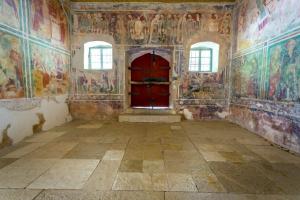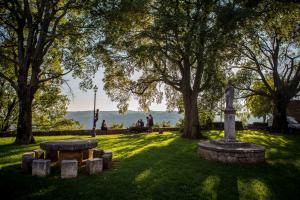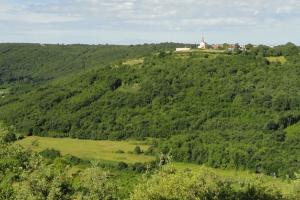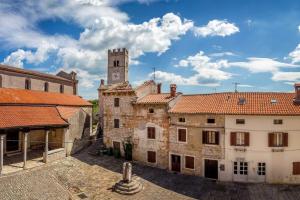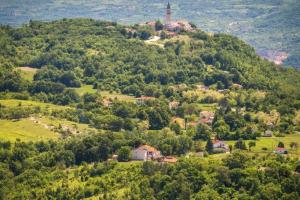Lindar
While we are approaching Pazin, taking the road that goes north-east through the valley of the Pazinčica rivulet, we will spot the bell tower of Lindar at the hilltop ahead of us, peeping out from the dense forest as if it was watching us. We should recall the scene again, once we visit this prehistoric site. Such a prominent position of the guard must have been one of the main reasons for the construction of Lindar, which was once a fort girdled by strong walls and towers. The fort used to protect the entrance to Pazin Castle, from which it is only 2.5 km away. This is the reason why antiquity scholars claim that a prehistoric settlement must have existed on this particular site. Yet, no solid physical evidence has been found up to the present day, apart from a pottery fragment and a piece of an iron object from the neighbouring hilltop, where today the cemetery of Lindar is.
It was from the Lindar lookout where defenders observed numerous tumultuous events that unfolded in the valley beneath them. They witnessed the count of Krk, Ivan Frankopan together with his soldiers, devastate Cerovlje and Zarečje in 1463,after which he heads towards Pazin Castle but eventually, instead of attacking it, he moves towards the not so well-protected Kašćerga and Sovinjak. They also monitored moves and breakout attempts from the Turks, who in 1501 encamped in the close proximity to Lindar, along the today’s road to Velanov brijeg. With deep anxiety they watched the intervention of Captain Lazarić at dawn of 4th September 1813, when together with only 47 soldiers and helped by a lot of pheasants, whose role was to make noise, he attacked the French army beneath Lindar and forced it to flee to Pazin, which brought the whole Istria back under the Austrian rule. It is said that the women of Lindar contributed to the stratagem of the Captain too, by positioning their spindles in a way that these protrude from the walls, thus suggesting that the fort was well-defended.
At Lindar, the Glagolotic script, which is the oldest Slavic script, had been used from time immemorial. Apart from the original Glagolitic inscriptions carved in stones in the churches of St. Martin, St. Sebastian, and St. Mohor and Fortunato, there were also graffiti on the frescoes in the church of St. Catherine. The registers of Lindar were written in Glagolitic script from their introduction in 1590 until 1667, while in the 15the century, a Glagolitic priest Petar Fraščić was active in Lindar. He bequeathed to us one, and so far the only known commented Glagolitic psalter, which he wrote in 1463 for "priest Matija of Kubed".












